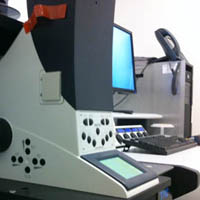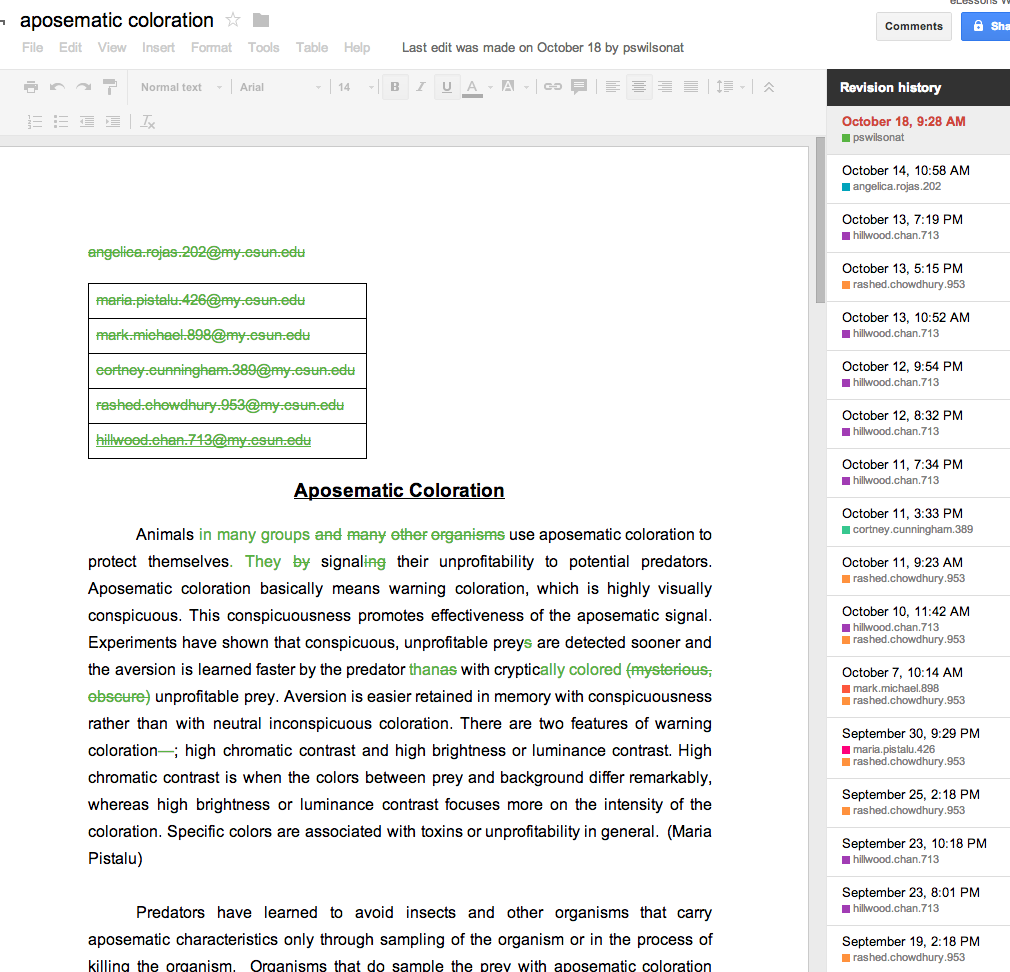
Paul's Academic Technology Gallery
| This is a gallery of a variety of lessons that are somehow technological. CLICK ON THE PICTURE to proceed to the specific example (it's large just in case you're using your thumbs). For iPad apps featured at faculty retreat, click HERE. |
 |
Check out the mollusk display on the first floor of Chaparral Hall between CR5124 and CR5125. The audio that accompanies it takes about half an hour to listen to. The cabinet was set up by Lareen Smith. |  |
An audio-only lecture on the basic biology of bees. It was made with only an iPhone, not a fancy mic. The class and I were out of doors. It worked fine. We also took some picktures that we put in a slideshow in Flickr. |
 |
A slideshow reviewing stream organisms along with bits of information about their trophic roles. This was made in Keynote with just the iMac's built-in mic. |  |
My old-time radio show, The Evolution Report, with interview of my heroes. Unfortunately, these were made before I discovered how much it helps to wear a microphone on one's head. |
 |
e-lesson to pre-training future users of the confocal microscope—30 short videos in Youtube embedded in a lesson made in Softchalk, which faculty can download. The star of the show is Mark Armitage, our microscopist, and the videos were edited by Bryan Smith. | Audio-only lecture on the flow of fixed carbon and nitrogen through a stream. This was made with a Shure WH20 dynamic headset mic connected to a Zoom H4n recorder. I am recording all my lectures in the field this way (BIOL 323 Plants & Animals of s CA). | |
 |
Campus Quality Fee money has funded lecture capture in the large lecture rooms, and professors can download a personal version of echo360 for use anywhere. |  |
My other course (BIOL 322 Evolutionary Biology) in Moodle 2. As guest, type friend and enter. Lots of examples of Lecture Capture to look at there. |
 |
My students coauthor papers in groups of five coauthors. This is done in Google Docs where we can See Revision History. They fill out three peer evaluations—for initial draft, helpfulness in editing, and order of authorship. |  |
Here is the Wordpress site where students can blog in photos or text about the class. |
 |
This is a Voicethread of some water birds we saw at Sepulveda, narrated by Joseph Algiers. We've made Voicethreads for many of the groups studied in Plants and Animals, as a first-pass at learning. |  |
Movie file, made in Keynote exported as for iPod. Made with headset mics. Interview of Joseph Algiers. I like the conversational quality of the clip, even though it takes longer than a straight lecture. |
Generalizations, suggested
- Sound quality is important. Microphones are less expensive than your time. Humans have learned aurally for tens of thousands of years, possibly for a hundred thousand years.
- If you don't need visuals—or even if you only need a few still images—then stand-alone audio is better than video or a sideshow. It frees the students from being tethered to their computers. Three bars on a smart phone is enough for audio, or they can download for later listening. You can always give them a few images separately.
- Information, such as I teach, varies from simple to complex in various ways. Find the right tool for the job.
• Simple information, like vocabulary, should be doled out in small punchy chunks. I would go for 3-10 minute pieces, and if you can count on students being motivated, follow each chunk with a self-quiz or other activity that moves information from short-term memory to medium-term memory.
• How-to information is generally very visual. Pull that lever, then twist this knob. Use video to show kinematics. It also is easy to teach as chunk-and-quiz, chunk-and-quiz.
• Abstract topics are best approached (initially) in a fuzzy way. Conversation between two people is a very natural way to talk, and a very natural way to eavesdrop. You probably won't be able to cut this into tiny pieces or exactly pin-point what you want them to know. Do that later, after the first time they've heard about it.
• Processes are nicely taught by drawing cartoons, like on a chalk board, but these days on a tablet with a stylus, then add voiceover. Click HERE for iPad app recommendations of Cheryl van Buskirk. - Repitition helps. Give it to them in a lecture, in text, in an audio recording, then in quizzes, in group-learning exercises, boil it down for them into principles, give review sessions, test them, and make it cumulative through all the tests. Your goal is to make them unable to not think about the world around them in the terms of the class.
- Music and images can set the mood, and mood is important. Students don't mind watching feature films even though they take longer than a standard CSUN lecture. Why? It's entertaining! Get a good soundtrack.
 To paraphrase: "Students don't learn like they used to, so why are we still teaching that way?" True (though perhaps pathetic).
To paraphrase: "Students don't learn like they used to, so why are we still teaching that way?" True (though perhaps pathetic).
• Notetaking as it was known before the mass production of the mimeograph machine is dead as a doornail; Powerpoint killed the last vestige. So, you must provide some kind of notes or recording of your pontifications (preferably both), or else they cannot review your pearls of wisdom.
• Studying, which once upon a time involved creating one's own flash cards, drawing a master plan on butcher paper, and composing one's own outline of q class, is now a foreign concept. It can be re-introduced if you want to take the time, but various forms of social learning and spoon-feeding are more familiar and might work better (in the short term).
• Reading books, whole books to be savored and digested, is under serious challenge. Of course, some students (who are like to'al loners) have consumed a large number of books since they were in 2nd grade, but many others have not, and if you want them to get a lot out of the text, you need to enforce relentless discipline that surrounds the readings. Demand that they write responses to each piece. Or force them to take quizzes. It is possible, but you'll have to expend your limited professorial capital.- There is no silver-bullet. Making your class slick is nice, and I encourage it, but don't think that it will work miracles. On the other hand, if you have a big problem, you might as well try to make it less of one. See the movie Michael Clayton: "I'm not a miracle worker; I'm a janitor."